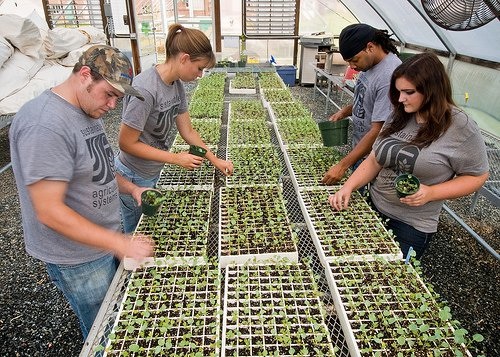Farms are energy hungry enterprises that need power for equipment, farming, processing and packaging. In 2007 the U.S. Department of Agriculture (USDA) launched a renewable energy program that would provide hundreds of thousands of dollars in funding to support wind, solar, geothermal and hydroelectric projects on U.S. farms and rural businesses. The idea was that by helping struggling farmers and small business owners to invest in renewable energy technology, Rural Energy for America Program (REAP) could help save those individuals thousands of dollars in energy costs.
By the end of November 2011, the program had already approved $30 million in loans and grants to 516 farmers nationwide, for projects including a 8.36 kilowatt (kW) solar photovoltaic system for a dairy farm in Massachusetts; energy efficient air compressors, boilers, temperature and lighting controls for a steel factory in Kansas; and a new, energy efficient grain dryer for a farmer in South Dakota. Now, the USDA is ready to boast of the REAP’s success. In late March, Agriculture Secretary Tom Vilsack released a report outlining the projects that are under way and reminding other eligible farmers, ranchers and rural business owners that they could be next in line.

Titled, “The Impact of the Rural Energy for America Program on Promoting Energy Efficiency and Renewable Energy,” the report boasts that REAP has been extra active since President Obama took office, supporting a total of 5,733 renewable energy and energy efficiency projects nationwide and providing $192 million in grants and $165 million in loan guarantees to agricultural producers and rural small business owners.
But even before the government hopped on the bandwagon, American farmers were noticing the cost effectiveness of energy efficiency and renewable energy technology. According to the USDA, the rate of solar installation on farms increased almost five times between 2000 and 2009. With the REAP programs, farms saw a five-fold increase in solar installations in just two years, from 2007 to 20o9.
But REAP also funds a host of other kinds of energy technologies, including biodigestors that use organic waste matter and transform it into methane gas for power, small-scale wind turbines, flex fuel pumps, biogas and wood-to-energy biomass projects. Energy efficiency projects include grain dryers, lighting efficiency projects, reverse osmosis systems, irrigiation systems and building efficiency programs. Each of the projects costs only a few thousand dollars but can ultimately save many more thousands in the long run.
The greatest number of projects so far has been in Iowa, with a total of 1,128 projects, $38,431,390 invested in grant money, $46,358,749 provided in loans and a grand total of 871,286 kilowatt-hours (kWh) of electicity generated from the projects. REAP has been far less popular in the other 49 states, with the second greatest number of installations at less than a half of Iowa’s: Minnesota has 512 REAP energy projects and receieved $12,548,264 in grants, $5,136,337 in loan guarantees but its farmers produce even more power than in Iowa: a grant total of 994,724 kWh of renewable electricity.

In the middle of the USDA report is a blocked quote from President Obama, from this March: “We’re not going to be able to just drill our way out of the problem of high gas prices… If we are going to control our energy future, then we’re got to have an all-of-the-above strategy. We’ve got to develop every source of American energy-not just oil and gas, but wind power and solar power, nuclear power, biofuels.”
REAP offers eligible farmers and business owners either grants, loan guarantees or a combination of the two for construction of renewable energy as well as energy efficiency technology. USDA will be accepting applications to the program through its website until June 29. Authorized under the Food, Conservation, and Energy Act of 2008, REAP funding can be used for renewable energy systems, energy efficiency improvements, feasibility studies, energy audits and renewable energy development assistance. More information is available online.